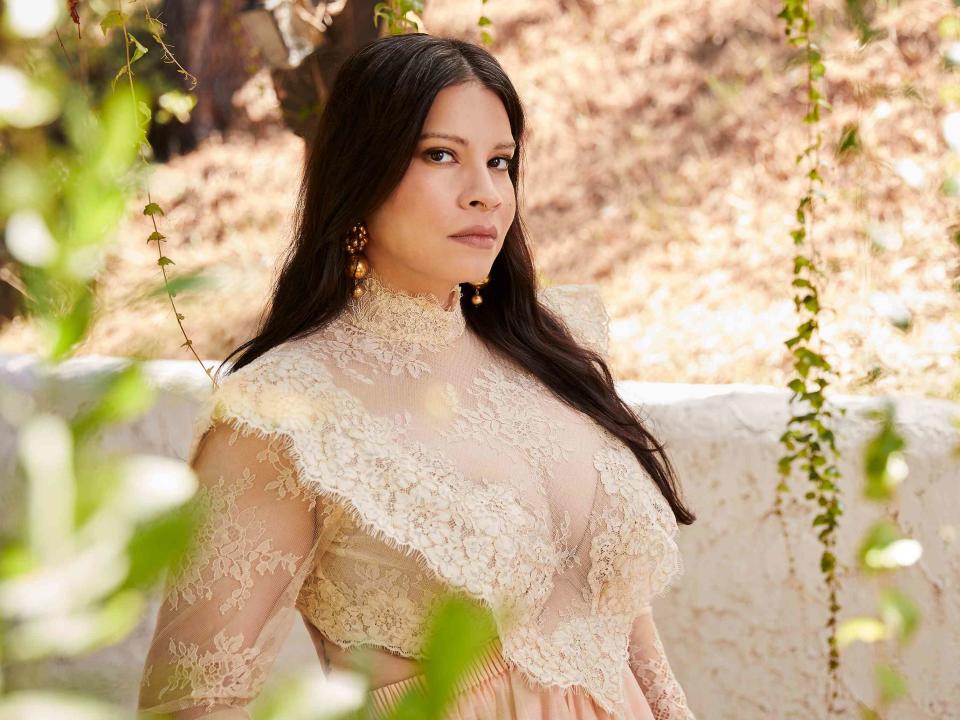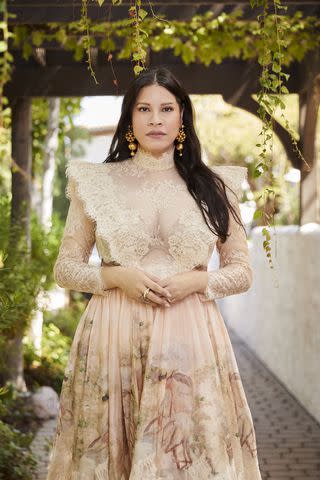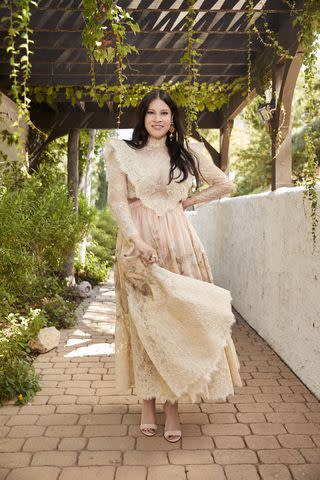Cara Jade Myers Is Just Getting Started
- Oops!Something went wrong.Please try again later.
- Oops!Something went wrong.Please try again later.
- Oops!Something went wrong.Please try again later.
- Oops!Something went wrong.Please try again later.
- Oops!Something went wrong.Please try again later.
- Oops!Something went wrong.Please try again later.
Starring in Martin Scorsese’s ‘Killers of the Flower Moon’ led the actress to understand the gravity of representing Indigenous people on screen.

JSquared (Joe Magnani & Jared Schlachet)
When Cara Jade Myers started acting, she didn’t intend to be someone else’s on-screen representation. She’s happy to do it, but — first and foremost — she performs for herself. “I never really was like, Oh, I'm going to do this for other people,” she tells InStyle over the phone as she’s trying on outfits for a press junket. It’s mere days after the SAG-AFTRA strike ended, and the media is clamoring to speak with the cast of one of the most critically acclaimed films of the year. “[Acting] was always for me because it was something that made me happy, that I enjoyed.”
It wasn’t until starring in Martin Scorsese’s triumphant-yet-harrowing 10-time Oscar-nominated film, Killers of the Flower Moon, that the 39-year-old actress started to understand the importance of being part of the diversification of Hollywood. As depicted in the movie, in the 1920s, families in the Osage Nation became targets for greedy white men who were after their oil money — which they set out to collect through marriage or murder. An estimated 60 Native people were killed during this time period, referred to as the “Reign of Terror.” Indigenous people reached out to applaud Myers for being a part of the film and shared their reactions. (One Native mother told Myers about the moment her daughters realized that the slain Henry Roan was their great-grandfather.) Her friends were moved to tears seeing Myers on the red carpet at the Cannes Film Festival alongside Scorsese and her co-stars Leonardo DiCaprio and Robert De Niro. The significance of what she was doing began to sink in.
“The more I talked to people, especially Natives, the more I started to realize: This is something,” Myers shares. “I knew [the film] was important, but I guess I didn't understand the gravity of it until I was like, This really is something that our youth need to see.”
Representation wasn’t something Myers saw growing up — on or off the screen. She was born into the Wichita and Kiowa tribes, but didn’t live on the reservation and was not immersed in the culture because of her family circumstances. When her biological father turned abusive, she says, her mother moved the family from Oklahoma to Arizona. There, she met and married Myers’s step-father, who was controlling.
“[My Mother and I] weren't allowed to go places or else it would cause this big fight,” she recalls. “We were very isolated from [family and friends] growing up. I always felt kind of disconnected from my tribe that way.”
While movies and TV shows can often serve as a refuge for lonely children, Myers’s family was too poor to afford a television set most of the time. On the few occasions that she spent a day at the theater, she didn’t see much diversity on screen. When there were Indigenous people in movies, Myers remembers them being cast in offensive, stereotypical roles. “They're in buckskin back in the 1700s, and they're the villains.”
“It just became this thing where I didn't see myself, so I didn't think I could do it,” she adds.
But her desire to “escape” her life and “create stories” in her head as a kid eventually turned into an interest in writing and performing as an adult. It was ultimately her husband, Josh, who encouraged her to study acting. Three or four times a week, she would drive two hours to Phoenix for class. They eventually decided to move to Los Angeles so Myers could audition for parts; she worked as a production assistant on sets in between.

JSquared (Joe Magnani & Jared Schlachet)
Myers nabbed one-episode cameos in TV shows like This Is Us and Rutherford Falls, and starred in several short films. However, getting cast as an Indigenous person was a different beast. “As soon as people find out that you're Native American, it's suddenly that a cop is no longer a cop,” she says. “They're a tribal cop on the reservation living in a teepee.”
When Myers first started out in the business about 16 years ago, no one knew how to “write for Native Americans. …The issue was trying to find roles for Native Americans that, number one, were accurate. Number two, weren't stereotypical. Number three, just even having a role — that’s kind of where it starts, and there just aren’t that many roles.”
Then, in 2019, came Killers. Myers submitted self-taped auditions for both the roles of Reta and Anna Brown, two of the sisters in the family at the center of Scorsese’s adaptation of the nonfiction book of the same name. After four auditions, the coronavirus pandemic shut down the world with no word of whether the film would get made. In late 2020, Myers went on to audition again over Zoom for Scorsese and won the role of Anna, one of the Osage members killed during the massacre.
Filming in Oklahoma turned out to be a homecoming of sorts for Myers. After spending so much of her life detached from her Native roots, the actress was able to reconnect with her heritage while researching and meeting with the people of Osage County. “[They] were so willing to share their culture,” she says. The tribe members educated the cast on their traditions, told them stories, and showed them landmarks and locations where some of the real-life murders took place. Myers visited the grave site of her character Anna, alongside her castmates Lily Gladstone, Jillian Dion, and Janae Collins, who play her sisters Mollie, Minnie, and Reta, respectively.
“They're all buried together, and we were all crying,” Myers recalls. “These stories are still very much enriched in the [Osage community]. It still affects them today, and it affects how they talk and move.”
Myers spoke with locals about Anna, letting people’s personal ties and first-hand accounts inspire her highly-praised portrayal. Someone even described the rambunctious sister to Myers as a “hurricane of chaos,” a quality that came across each time Myers whizzed through Mollie’s house. But, Myers took some creative liberties, as well, like having Anna’s drinking problem stem from her sister Minnie’s death.
To Myers, getting the tribe’s approval on her performance (and the entire film) meant more than any Golden Globe, SAG, or Oscar nomination. (Although, the film racked up quite a few of those, too — the cast is nominated for SAG’s top honor at this weekend’s ceremony.) “You're on their land; you're telling their story,” Myer says. “I was like, Even if this movie gets zero critical acclaim or anything, if the Osage are happy with it, then I'll be happy with it.”
After a screening in Tulsa in July 2023, Myers said the reviews from the tribe were split — some weren’t sure how to feel. “It's such a heavy and dense movie that it's okay to not know how you feel, especially if these are your stories,” Myers sympathizes. “It's different from hearing them versus seeing them.”

JSquared (Joe Magnani & Jared Schlachet)
Accurately telling the Osage’s story wasn’t just important to Myers and the 63 credited Indigenous people in the cast. In an interview with Time, Scorsese explained that after meeting the Osage people, the Oscar-winning director reworked the script entirely to put more of a focus on the Indigenous people and less on the “white guys.”
Industry veterans De Niro and DiCaprio play the money-hungry “white guys:” the calculated and manipulative ring leader William Hale and his submissive greedy nephew and husband to Mollie, Ernest Burkhart. Titanic being one of the few movies Myers saw in theaters made this experience a full-circle moment. (She and Gladstone even asked the star why Jack couldn’t fit on the door with Rose. His response? “I don’t know.” “I am sure he gets tired of hearing all the jokes,” she adds.) The legends, however, were nothing but “incredibly welcoming.”
Garnering recognition and generating awards season buzz may not have been the goal of the film, but there’s no question that the attention helps further highlight the tragic yet important story, and encourage diversity at the hallowed — and oftentimes exclusive — awards ceremonies and red carpets. Gladstone made history at the Globes as the first Indigenous woman to take home the trophy for Best Performance by a Female Actor in a Motion Picture - Drama (and delivered a moving speech, partially in Blackfeet language). Myers has used the opportunity to showcase Native American designers, often wearing jewelry from Indigenous creators on red carpets. She’s become a new player in the fashion industry, being dressed by major brands like Self-Portrait, Petar Petrov, and Tory Burch. The actress even appeared in Rodarte’s star-studded Spring 2024 campaign.
The world is watching Myers. Whether it’s aspiring Indigenous actors, fashion fans, or the Hollywood critics, the actress’s rise paves a path of representation for, hopefully, many to come. Where does one go after appearing in a Scorsese movie that is nominated for the Academy Award for Best Picture? She’s starring alongside Joel Kinnaman in the thriller Ice Fall, she’s shopping around multiple scripts she wrote herself with her own production company, and she’s going to use her newfound platform to create change by hiring and mentoring Native people. In a more immediate sense? I can hear Myers on the other line putting the finishing touches on her press day ensemble, as the rising star is whisked away to tell her story.
More Celebs You’ll Love
For more InStyle news, make sure to sign up for our newsletter!
Read the original article on InStyle.

